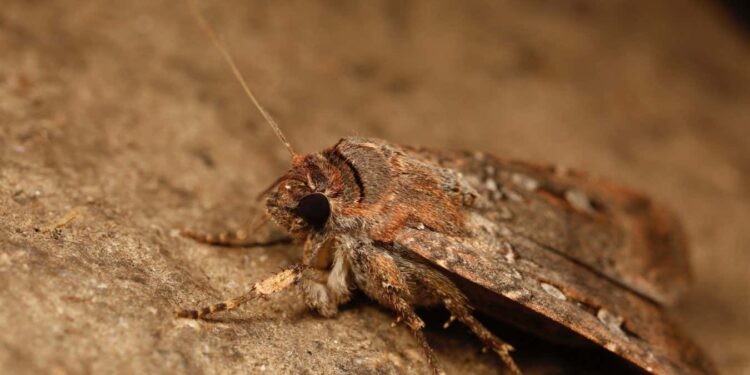
Bogong moths migrate to cool caves in the summer
Dr. Ajay Narendra/Macquarie University, Australia
An Australian moth that migrates over 1000 kilometres to seek respite from summer heat is the first known invertebrate to use the stars as a compass on long journeys.
Every spring, billions of bogong moths (Agrotis infusa) travel from various parts of southern Australia to cool caves in the Australian Alps after spending the winter as caterpillars feeding on vegetation. Once in the caves, they have a long period of inactivity, called aestivation, before returning to their breeding grounds.
It has long been a mystery exactly how these moths, whose numbers have been collapsing in recent years, navigate so far to these high country caves, says Andrea Adden at the Francis Crick Institute in London.
Previous studies have shown that they are able to use Earth’s electromagnetic field, but only in combination with landmarks they can see. Adden and her colleagues wanted to find out what other cues the moths may be using to navigate.
“If you go to the Australian bush, where these moths live, and look around at night, one of the most striking visual landmarks is the Milky Way,” she says. “We know that daytime migratory insects use the sun, so testing the starry sky seemed an obvious thing to try.”
To do so, the team caught moths during their migration using light traps and took them to a lab. There, the insects were placed in a Perspex arena and an image of the night sky was projected onto a screen above them. The moths were tethered inside the arena, but could pick a flight direction based on the sky image. The researchers used a device called a Helmholtz coil to essentially cancel out Earth’s magnetic field.
The tests showed that the moths use a stellar compass, says team member Eric Warrant at Lund University, Sweden. “When tethered moths were placed under highly realistic local starry night skies, they flew in their inherited migratory direction,” he says. “They did this solely with the help of these stars – all other visual cues, as well as the Earth’s magnetic field, were absent.”

Caption: Aestivating moths in an alpine cave in the summer (there are around 17,000 moths/m2 of cave wall and millions in each cave)Copyright: Eric Warrant
Eric Warrant
When the team turned the starry sky by 180 degrees, moths flew in the opposite direction, and when they randomly redistributed the natural stars across the image they were completely disoriented.
In a second experiment, the moths were fixed in place with a very thin electrode inserted in their brains. This revealed changes in the moths’ neural activity when the projected sky image was rotated.
Although dung beetles use the Milky Way to stay on the same bearing over short distances, no insect was known to use celestial navigation for migration until now.
“The bogong moth is the first invertebrate we know of that is able to use the stars as a compass for long-distance navigation to a distant destination that it has never previously been to,” says Warrant. “Only humans and some species of night migratory birds are known to have this ability.”
Another insect famous for long-distance migrations, the monarch butterfly (Danaus plexippus), uses the sun to navigate, factoring in the time of day.
Cody Freas at Macquarie University in Sydney, Australia, says it is remarkable what insects can do with quite a simple visual system. “Stellar navigation really showcases the abilities of these small compound eyes in nocturnal insects to navigate across different cues – sun, moon and stars – as well as working even in extremely dim light levels,” says Freas.
Topics:
Source link : https://www.newscientist.com/article/2484724-australian-moths-use-the-stars-as-a-compass-on-1000-km-migrations/?utm_campaign=RSS%7CNSNS&utm_source=NSNS&utm_medium=RSS&utm_content=home
Author :
Publish date : 2025-06-18 16:00:00
Copyright for syndicated content belongs to the linked Source.











